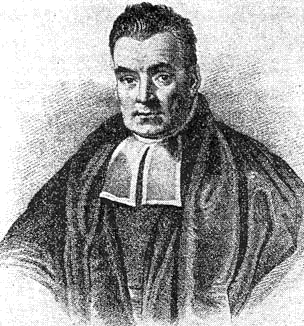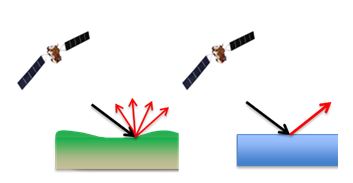Code
%matplotlib widget
import numpy as np
from eomaps import Maps
from tuw_education_notebooks.view_bayes_flood import view_bayes_flood
from tuw_education_notebooks.calc_bayes_flood import sig0_dc, calc_likelihoodsHow an 275 year old idea helps map the extent of floods

%matplotlib widget
import numpy as np
from eomaps import Maps
from tuw_education_notebooks.view_bayes_flood import view_bayes_flood
from tuw_education_notebooks.calc_bayes_flood import sig0_dc, calc_likelihoodsThis notebook explains how microwave (\(\sigma^0\)) backscattering (Figure 1.1) can be used to map the extent of a flood. We replicate in this exercise the work of Bauer-Marschallinger et al. (2022) on the TU Wien Bayesian-based flood mapping algorithm.
In the following lines we create a map with EOmaps (Quast, n.d.) of the \(\sigma^0\) backscattering values.
m = Maps(ax=121, crs=3857)
m.set_data(data=sig0_dc, x="x", y="y", parameter="SIG0", crs=Maps.CRS.Equi7_EU)
m.plot_map()
m.add_colorbar(label="$\sigma^0$ (dB)", orientation="vertical", hist_bins=30)
m.add_scalebar(n=5)
m2 = m.new_map(ax=122, crs=3857)
m2.set_extent(m.get_extent())
m2.add_wms.OpenStreetMap.add_layer.default()
m.apply_layout(
{
'figsize': [7.32, 4.59],
'0_map': [0.05, 0.18, 0.35, 0.64],
'1_cb': [0.8125, 0.1, 0.1, 0.8],
'1_cb_histogram_size': 0.8,
'2_map': [0.4375, 0.18, 0.35, 0.64]
}
)
m.show()Reverend Bayes was concerned with two events, one (the hypothesis) occurring before the other (the evidence). If we know its cause, it is easy to logically deduce the probability of an effect. However, in this case we want to deduce the probability of a cause from an observed effect, also known as “reversed probability”. In the case of flood mapping, we have \(\sigma^0\) backscatter observations over land (the effect) and we want to deduce the probability of flooding (\(F\)) and non-flooding (\(NF\)).
In other words, we want to know the probability of flooding \(P(F)\) given a pixel’s \(\sigma^0\):
\[P(F|\sigma^0)\]
and the probability of a pixel being not flooded \(P(NF)\) given a certain \(\sigma^0\):
\[P(NF|\sigma^0).\]
Bayes showed that these can be deduced from the observation that forward and reversed probability are equal, so that:
\[P(F|\sigma^0)P(\sigma^0) = P(\sigma^0|F)P(F)\]
and
\[P(NF|\sigma^0)P(\sigma^0) = P(\sigma^0|NF)P(NF).\]
The forward probability of \(\sigma^0\) given the occurrence of flooding (\(P(\sigma^0|F)\)) and \(\sigma^0\) given no flooding (\(P(\sigma^0|NF)\)) can be extracted from past information on backscattering over land and water surfaces. As seen in the sketch below (Figure 1.2), the characteristics of backscattering over land and water differ considerably.

The so-called likelihoods of \(P(\sigma^0|F)\) and \(P(\sigma^0|NF)\) can thus be calculated from past backscattering information. Without going into the details of how these likelihoods are calculated, you can click on a pixel of the map to plot the likelihoods of \(\sigma^0\) being governed by land or water.
view_bayes_flood(sig0_dc)Having calculated the likelihoods, we can now move on to calculate the probability of (non-)flooding given a pixel’s \(\sigma^0\). These so-called posteriors need one more piece of information, as can be seen in the equation above. We need the probability that a pixel is flooded \(P(F)\) or not flooded \(P(NF)\). Of course, these are the figures we’ve been trying to find this whole time. We don’t actually have them yet, so what can we do? In Bayesian statistics, we can just start with our best guess. These guesses are called our “priors”, because they are the beliefs we hold prior to looking at the data. This subjective prior belief is the foundation Bayesian statistics, and we use the likelihoods we just calculated to update our belief in this particular hypothesis. This updated belief is called the “posterior”.
Let’s say that our best estimate for the chance of flooding versus non-flooding of a pixel is 50-50: a coin flip. We now can also calculate the probability of backscattering \(P(\sigma^0)\), as the weighted average of the water and land likelihoods, ensuring that our posteriors range between 0 to 1.
The following code block shows how we calculate the priors.
def calc_posteriors(water_likelihood, land_likelihood):
evidence = (water_likelihood * 0.5) + (land_likelihood * 0.5)
return (water_likelihood * 0.5) / evidence, (land_likelihood * 0.5) / evidenceWe can plot the posterior probabilities of flooding and non-flooding again and compare these to pixel’s measured \(\sigma^0\). Click on a pixel to calculate the posterior probability.
view_bayes_flood(sig0_dc, calc_posteriors)We are now ready to combine all this information and classify the pixels according to the probability of flooding given the backscatter value of each pixel. Here we just look whether the probability of flooding is higher than non-flooding:
def bayesian_flood_decision(id, sig0_dc):
nf_post_prob, f_post_prob = calc_posteriors(*calc_likelihoods(id, sig0_dc))
return np.greater(f_post_prob, nf_post_prob)Click on a point in the below map to see the likelihoods and posterior distributions (in the left-hand subplots).
view_bayes_flood(sig0_dc, calc_posteriors, bayesian_flood_decision)